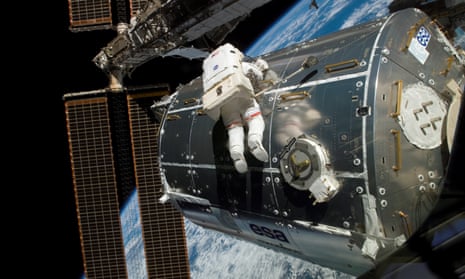The International Space Station, that $160bn assemblage of aluminium, titanium, steel and Kevlar in which the Briton Tim Peake is currently living 250 miles above Earth, is a masterpiece of architecture and engineering to rank with the Eiffel Tower and the Golden Gate Bridge. So writes David Nixon, an architect who himself worked on aspects of its design. In this he is following a tradition in modern British architecture, which loves to find inspiration for Earth-bound buildings in things that fly and orbit.
It is certainly a wondrous thing, a bright, white, multi-winged dragonfly wider than the Statue of Liberty is tall, whose multiple layers of protection and servicing serve to protect a home for a few human beings at a time, in surroundings of extreme hostility to life. It had to be built in conditions of exceptional difficulty as if, as it says in Nixon’s book, one were building a ship in mid-ocean, from the keel up.
Outside the constraints of Earthbound gravity, its structure follows different rules. It has a different concept of “up” and “down”. It has the convincing quality of most objects designed to meet extreme functional imperatives.
It has to solve problems never before encountered, and get very many details absolutely right, or face fatal consequences. It offers the satisfactions of an elaborate toy, with attachments and visiting spacecraft that can be clipped on and off as if with a giant Lego set.
It is romantic, offering a dream of escape to a world beyond weight and weather. It seems ageless, though actually it is not – sooner or later it will be brought down into the Pacific in a controlled crash. At the same time, as a place of habitation, it is human, and some of the more striking images in Nixon’s book show the ways in which people play music, exercise or wield a vacuum cleaner in interiors less pristine than you might expect. Some of the more intriguing parts of his text concern the challenges of keeping people sane in space: the importance of including a window, for example, although it would be easier not to (or the salmon colour scheme that at one point in the design development was thought to be psychologically soothing).
There are striking details in Nixon’s account, such as the creaking noise, alarming to new arrivals at the space station, caused by its rapid heating and cooling in extreme temperatures. There is the “smell of space”, the “sweet metallic” odour emitted by objects brought in from outside. There is the fact that the top of astronauts’ feet harden, and their soles soften, as zero gravity requires them not to walk around but to stabilise themselves by hooking their feet under rails.
Nor is the space station a work of pure logic and function. Like any building project, it is the result of battles and compromises over cost. It is intensely political, given the go-ahead by President Reagan, scrutinised by Congress, debated in the media.
The fact that Nasa brings work to 90% of the United States’ congressional districts does much to explain why a project of such mind-boggling expense has survived the assaults of budget-cutters over decades. At a certain point it became international rather than purely American, with elements from Russia, Canada, Japan, Europe and elsewhere. Part of the design challenge was to find ways in which these disparate contributions could be attached to the overall structure.
And, in the end, it is hard to escape the view that it is the greatest architectural folly of all time. Its justifications have always tended to be sketchy. They include the vague aspiration of fostering international understanding, and the benefits of conducting research in space – treatment of osteoporosis, for example, might be improved through studying the effects of zero gravity on astronauts’ bones. But such colossal expenditure would almost certainly have produced greater medical advances if applied differently. Another justification is that the space station is a stepping stone to manned exploration of the solar system, but unmanned missions, such as the probes sent to outer planets and comets, and the Hubble telescope, have yielded greater wonder and understanding.
Nixon acknowledges the politics and the debates, but his heart is elsewhere. He simply loves the space station and is deeply fascinated by the technical processes of its design and making. Long sections of the book, as a result, are strictly for aficionados of such things. But if you want a beautifully illustrated and well-informed description of what is indeed one the most astonishing of human creations, this is one.
International Space Station is published by Thames & Hudson (£65). Click here to buy it for £52

Comments (…)
Sign in or create your Guardian account to join the discussion